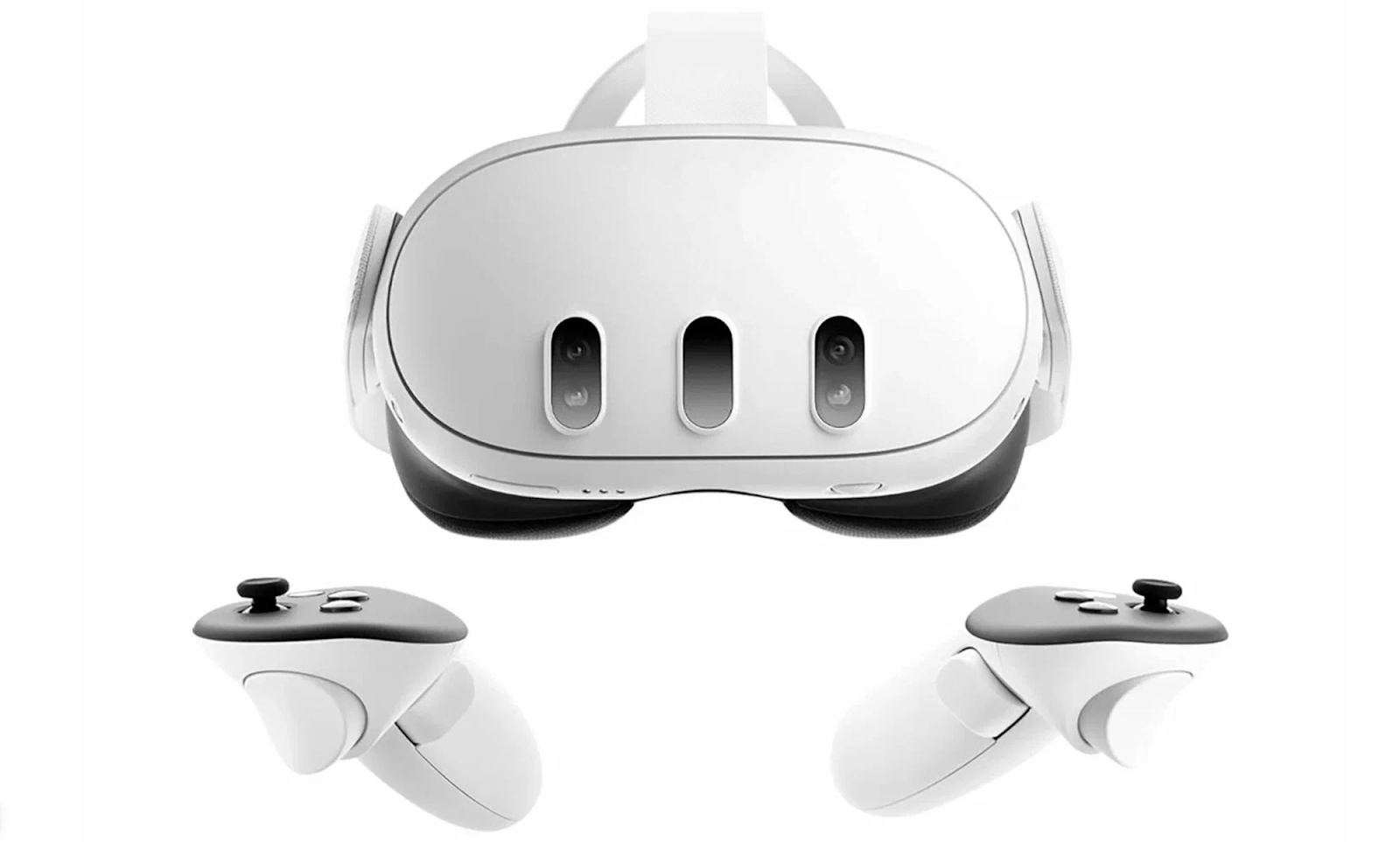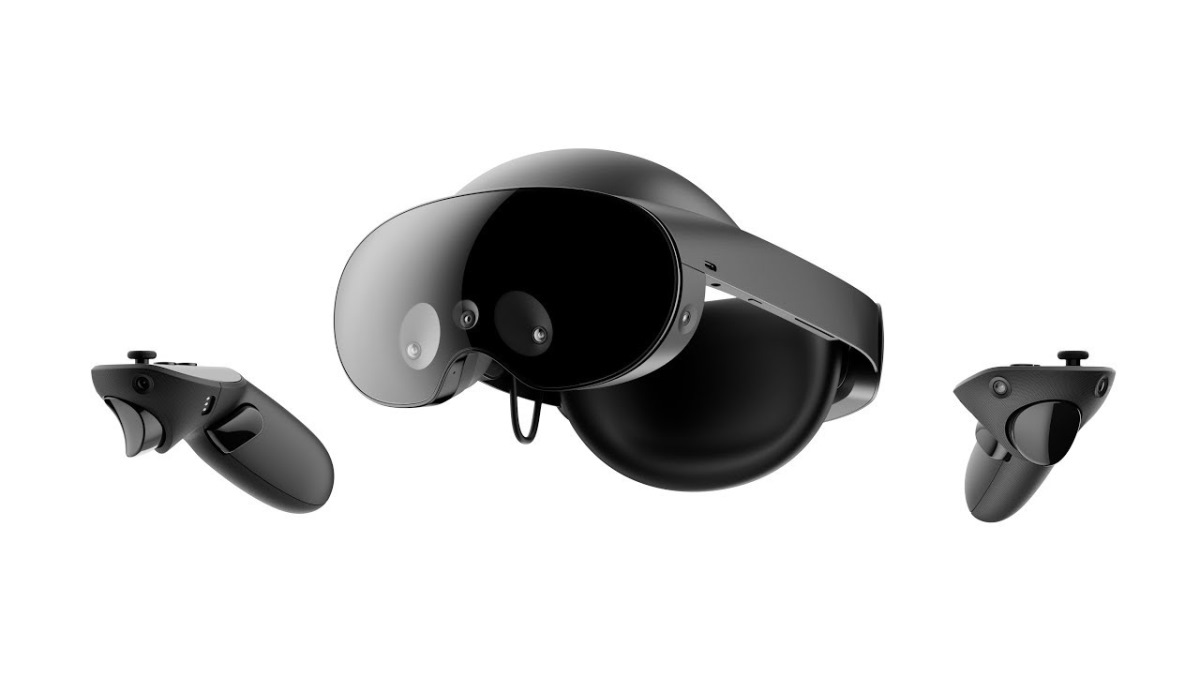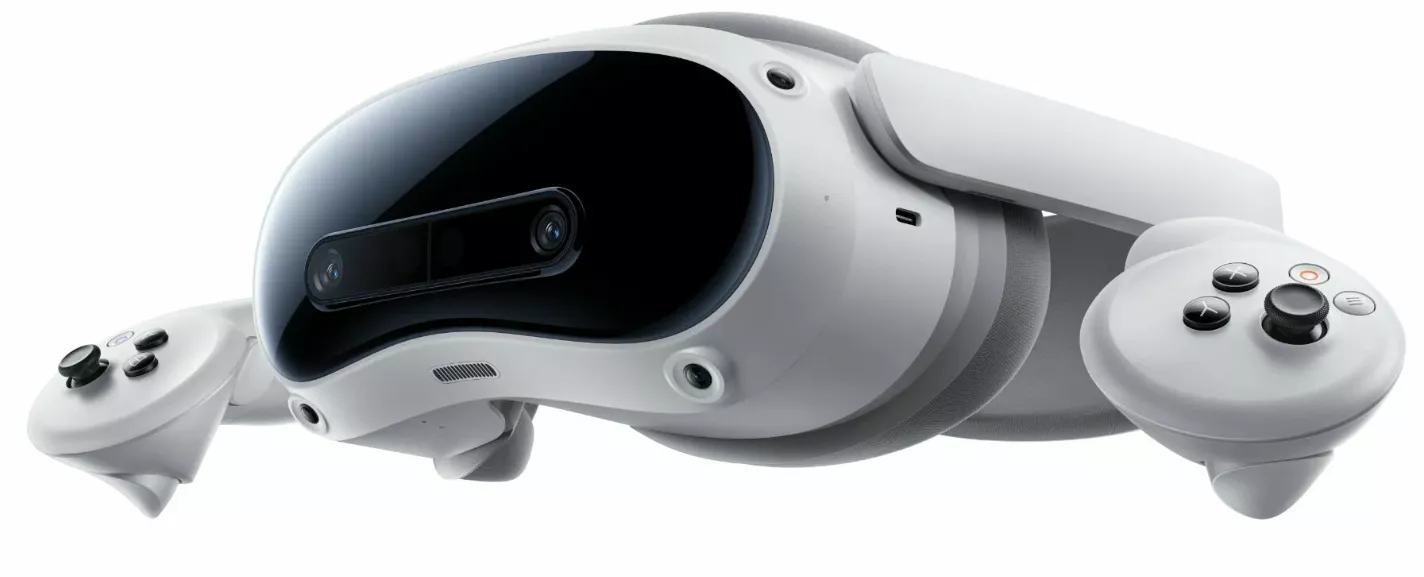Today’s VR headsets aren’t gadgets — they’re wormholes. Strap one on, and suddenly you’re sword-fighting skeletons in your socks or touring Mars while your coffee goes cold. The kicker? You don’t need a NASA budget or a PhD to jump in.
Why this year’s models hit different boils down to sweat-proof comfort and pixels so crisp, you’ll forget they’re not real. Take the best VR headset for gaming — it’s not just tracking your hands anymore. Eyes. It’s tracking your eyes. Creepy? Maybe. But when you’re dodging virtual bullets that feel like they’re grazing your cheek, you’ll stop caring.
VR for PC just got a glow-up. We’re talking wireless VR headset for PC setups that ditch the spaghetti of cables. Imagine playing Half-Life 3 (hypothetically, of course) with graphics so sharp, your GPU starts sweating. That’s the best VR headset for PC in 2025 — raw power without the cord chaos.
The Best VR Headsets in 2025
Meta Quest 3 – The Best Overall VR Headset

The Meta Quest 3 isn’t just good — it’s the best VR headset for folks who want it all without the fuss. Think of it as the Swiss Army knife of VR headsets (minus the actual knife). No wires, no PC required, just pure plug-and-play magic that turns your living room into a playground.
That Snapdragon XR2 Gen 2 chip sweats bullets when your gaming PC flexes its muscles. While it crushes standalone games like Beat Saber, hardcore titles like Half-Life: Alyx still beg for a cable tether. But hey — wireless freedom vs. pixel perfection? Most days, we’ll take the freedom.
Pros:
- Excellent standalone performance
- Crisp, high-resolution displays
- Intuitive Touch Plus controllers
- Wireless freedom with PC connectivity option
- Impressive mixed reality capabilities
Cons:
- Battery life limited to about 2 hours
- Default head strap could be more comfortable
- Premium accessories can get expensive
Meta Quest 3S – The Best Budget VR Headset

Tight on cash but craving VR? Say hello to the best budget VR headsett that doesn’t make your wallet cry. The Meta Quest 3S is like the Quest 3’s scrappy little sibling — $300 gets you 90% of the magic, minus the premium price tag.
Pros:
- Affordable entry into quality VR
- Same processor as Quest 3
- Full compatibility with Meta’s VR ecosystem
- Wireless design with PC connectivity options
- Great controllers
Cons:
- Lower resolution than Quest 3
- Fresnel lenses show more visual artifacts
- Basic head strap
- No headphone jack
Meta Quest Pro – Best for Enthusiasts

Most VRs treat your face like a mannequin’s. Not this beast. The Meta Quest Pro isn’t just a best VR headset — it’s a social chameleon for the digital age. Perfect for pros who need their virtual handshake to feel as real as their coffee burns.
Sure, the Quest 3 plays nicer PC gaming. But the Pro? It’s for creators sculpting 3D masterpieces, trainers teaching surgery in VR, or that one coworker who insists on “presence” in metaverse meetings. The dual LCD screens? Crisper than a fresh dollar bill, with colors that pop even when you’re elbow-deep in spreadsheets.
Pros:
- Advanced eye and face tracking
- Premium build quality and comfort
- Enhanced peripheral vision
- Better controller tracking
- Superior mixed reality capabilities
Cons:
- Significantly more expensive than Quest 3
- Battery life similar to cheaper models
- Bulkier than standard Quest headsets
- Overkill for casual VR users
ByteDance Pico 4 Ultra – The best alternate VR headset

Tired of Big Tech’s VR playground? Meet the best VR headset for rebels who want immersion without the ecosystem handcuffs. The Pico 4 Ultra isn’t just a Meta alternative — it’s a standalone powerhouse that’s got its own bag of tricks.
Pros:
- Excellent resolution and visual clarity
- Comfortable, well-balanced design
- Wi-Fi 7 support for superior streaming
- Growing content library
- Good value proposition
Cons:
- Not available in all regions (including the US)
- Ecosystem still smaller than Meta’s
- Occasional light leakage for glasses wearers
- Some tracking inconsistencies
Apple Vision Pro – Best VR Interface

The Vision Pro isn’t just a VR headset, but a crystal ball from the future. Apple’s luxury darling makes other headsets feel like flip phones. But here’s the rub: it costs more than your couch. Worth it? Depends how badly you want to watch Avatar 4 in a jungle that feels… alive.
Pros:
- Exceptional display quality
- Revolutionary controller-free interface
- Best-in-class mixed reality
- Premium build quality
- Seamless Apple ecosystem integration
Cons:
- Extremely expensive
- Limited gaming content
- External battery pack required
- Heavy for extended sessions
Sony PlayStation VR2 – Best Console VR Headset

If you’ve got a PS5 gathering dust, here’s its soulmate: the PSVR2. This isn’t just a VR for a wannabe — it’s Sony’s love letter to gamers who want to live their blockbusters, not just play them.
The sweet spot? Zero setup hell. Plug into your PS5, and boom — you’re climbing mountains or fleeing mutants in minutes. No PC tweaks, no driver updates. Just pure, unapologetic play.
Pros:
- Excellent OLED displays
- Comfortable design with adjustable fit
- Impressive haptic feedback
- Strong first-party game lineup
- Simple single-cable setup
Cons:
- Requires a PlayStation 5
- Cannot be used with PC
- Limited to Sony’s VR ecosystem
- Cable can be restrictive during active gameplay
Valve Index VR Kit – Best PC VR Headset for Gamers

Despite newer competitors, the Valve Index VR Kit continues to hold its position as the best VR for gaming in 2025. Its combination of tracking precision, controller design, and audio quality creates an unmatched experience for serious PC VR enthusiasts.
The Index’s displays offer a 1440 x 1600 per-eye resolution that, while no longer leading the spec race, still delivers crisp visuals. What keeps the Index competitive is its industry-leading 144Hz refresh rate and expansive 130-degree field of view, creating a smoother, more immersive experience than many newer headsets can match.
Pros:
- Superior refresh rate (up to 144Hz)
- Wide field of view (130 degrees)
- Best-in-class controllers with finger tracking
- Exceptional audio solution
- Precise base station tracking
Cons:
- Requires external base stations
- Higher resolution available in newer headsets
- Wired connection only
- Significant PC requirements
Comparison of the Best VR Headsets
| Headset | Resolution (per eye) | Refresh Rate | Field of View | Tracking | Standalone | PC Compatible | Price |
| Meta Quest 3 | 2064 x 2208 | Up to 120Hz | 110° horizontal, 96° vertical | Inside-out | Yes | Yes | $499 |
| Meta Quest 3S | 1832 x 1920 | Up to 120Hz | 96° horizontal, 90° vertical | Inside-out | Yes | Yes | $299 |
| Meta Quest Pro | 1800 x 1920 | 90Hz | 106° | Inside-out + eye/face | Yes | Yes | $999 |
| ByteDance Pico 4 Ultra | 2160 x 2160 | Up to 90Hz | 105° | Inside-out | Yes | Yes | $499 |
| Apple Vision Pro | 3660 x 3200 (combined) | 90Hz | 100° | Inside-out + eye/hand | Yes | Limited | $3,499 |
| PlayStation VR2 | 2000 x 2040 | 90-120Hz | 110° | Inside-out + eye | No | No | $549 |
| Valve Index | 1440 x 1600 | Up to 144Hz | 130° | External base stations | No | Yes | $999 |
How We Test VR Headsets
Our testing methodology for VR is comprehensive and hands-on, designed to evaluate every aspect of the VR experience. Here’s how we determine which headsets deserve your attention:
- Display Quality: We assess resolution, refresh rate, field of view, and lens quality. We look for crisp text, minimal “screen door effect” (visible pixel grid), and how well the headset handles high-contrast scenes. A great VR headset should make you forget you’re looking at screens.
- Comfort and Ergonomics: VR sessions can last hours, so comfort is crucial. We evaluate weight distribution, facial interface pressure, adjustability for different head sizes, and heat buildup during extended use. We also consider how the headset accommodates glasses wearers.
- Tracking Accuracy: Whether using inside-out tracking or external sensors, we test how accurately the headset and controllers follow your movements. We perform rapid movements, reach behind our backs, and play fast-paced games to identify any tracking limitations.
- Controller Design: We assess controller ergonomics, button placement, battery life, and tracking reliability. Great controllers should feel like natural extensions of your hands, not obstacles between you and virtual worlds.
- Performance: For standalone headsets, we evaluate how well they handle graphically demanding applications. For PC VR headsets, we test compatibility with different graphics cards and assess performance requirements.
- Content Ecosystem: Even the best VR hardware needs compelling software. We evaluate the quantity, quality, and variety of available apps and games, as well as the platform’s development momentum.
- Audio Quality: Immersive sound is essential for VR. We test built-in audio solutions and compatibility with external headphones, paying attention to spatial audio performance.
- Battery Life: For wireless headsets, we measure real-world battery performance across different types of applications and games.
After extensive testing across these categories, we assign scores and identify the strengths and weaknesses of each headset, helping you find the perfect match for your needs and budget.
Best VR Headsets of 2025: Buying Guide
When shopping for the best VR in 2025, several key factors should influence your decision:
- Purpose: Different headsets excel at different tasks. Are you primarily gaming? Consider a Quest 3 or Valve Index. More interested in productivity and mixed reality? The Apple Vision Pro might be worth its premium price. Casual exploration? The Quest 3S offers tremendous value.
- Standalone vs. PC-Connected: Standalone headsets like the Quest 3 offer convenience and portability but can’t match the graphical power of PC-connected options. If you already own a gaming PC, a VR might provide better value and performance.
- Resolution and Display Type: Higher resolution means sharper images and less visible pixelation. OLED displays offer better contrast and color than LCD, but often at a higher price. Pancake lenses provide a clearer image than older Fresnel designs.
- Tracking System: Inside-out tracking (cameras on the headset) offers convenience but sometimes sacrifices precision compared to external sensors. Consider how important tracking accuracy is for your intended uses.
- Controllers: Controller design varies significantly between platforms. Some emphasize ergonomics, others tracking precision or haptic feedback. The Apple Vision Pro even eliminates controllers entirely in favor of hand tracking.
- Comfort and Fit: A comfortable headset encourages longer sessions. Consider weight distribution, adjustability, and ventilation. Remember that the most powerful headset isn’t worth much if it’s too uncomfortable to use.
- Content Ecosystem: The best hardware needs great software. Meta currently offers the largest content library, while PlayStation has strong exclusive titles. Consider which games and applications matter most to you.
- Future-Proofing: VR technology continues to evolve rapidly. Consider whether a headset will receive ongoing software updates and support, and whether its specs will remain competitive for several years.
How to Choose the Best VR Headsets
Finding your ideal VR headset involves matching the technology to your specific needs and circumstances:
- For VR Newcomers: The Meta Quest 3S represents the best entry point. At $299, it offers a complete, wireless VR experience without requiring additional hardware. Its simplified setup and growing content library make it perfect for testing the VR waters.
- For Gamers: Your existing gaming setup should guide your choice. PlayStation 5 owners should consider the PSVR2 for its exclusive titles and seamless integration. PC gamers with powerful systems might prefer the Valve Index for its superior refresh rate and tracking precision. The Quest 3 offers versatility, working both standalone and with a PC.
- For Mixed Reality Enthusiasts: The Apple Vision Pro and Meta Quest 3 lead in blending virtual and physical worlds. The Vision Pro offers superior passthrough quality but at a much higher price, while the Quest 3 provides accessible mixed reality experiences for most users.
- For Business and Productivity: The Meta Quest Pro and Apple Vision Pro offer the best features for virtual workspaces and professional applications. The Vision Pro excels at display quality and intuitive interfaces, while the Quest Pro offers better value and broader compatibility.
- For Social VR: Consider headsets with good eye and face tracking if social presence matters to you. The Quest Pro and Vision Pro lead in this regard, creating more natural avatar interactions.
- For Small Spaces: Inside-out tracking systems like those in the Quest 3 and Pico 4 Ultra work well in limited areas. The PSVR2 and Valve Index VR headset require more setup space due to their external tracking systems.
- For Glasses Wearers: Look for headsets with adjustable lens distance or dedicated glasses spacers. The Quest 3 and PSVR2 accommodate glasses well, while the Vision Pro offers custom optical inserts.
Remember that the best VR headsets balance technology, comfort, content, and price. Consider which factors matter most for your specific situation rather than simply chasing the highest specs or newest release.
Conclusion
This year’s headsets aren’t just gadgets — they’re gateways. Whether you’re a broke college kid or a CEO with a gold-plated PC, there’s the best VR waiting to blow your mind.
The undisputed champ? The Meta Quest 3. It’s the pizza of VR — good hot, good cold, good anywhere. Standalone? Check. PC-powered? Yep. Library of games so big, you’ll retire before finishing them.
Best budget headset bragging rights go to the Quest 3S. Three hundred bucks gets you this close to its big brother’s thrills.
Now, for the specialists:
- PC purists: Valve Index. Those finger-tracking controllers? Pure wizardry.
- PS5 loyalists: The PSVR2 turns Horizon into a heart attack simulator (worth it).
- Apple addicts: The Vision Pro’s screens are so sharp, they’ll ruin reality for you.
VR’s no longer a rich-kid toy. Top headsets start at “impulse buy” prices, while high-end models make IMAX look like a postage stamp.
What’s next? Glasses-thin headsets? Brain-controlled interfaces? Sure, maybe. But 2025’s lineup? It’s the sweet spot. No waiting, no beta-testing, just play.
So pick your portal. Slash neon blocks in Beat Saber, conquer alien empires, or just watch cat videos on a 100-foot screen.
FAQs
What is the best VR headset?
The Meta Quest 3 is your golden ticket for most people — it’s the best VR headset 2025 that juggles gaming, workouts, and even awkward virtual coffee chats without breaking a sweat. Think of it as the smartphone of VR: not perfect, but damn near close enough.
However, “best” depends on what you’re after. Hardcore PC gamers might drool over the Valve Index and its buttery-smooth refresh rates, while PlayStation die-hards should shack up with the PSVR2 for exclusive thrills like dodging robot dinosaurs. And if money’s no object? The Apple Vision Pro is basically VR’s Lamborghini — overkill for groceries, glorious for flexing.
What VR headset should I buy?
Got $300 and just wanna dip toes? Grab the Meta Quest 3S. It’s the Honda Civic of headsets — reliable, does the job, no fancy bells. Perfect for first-timers slicing blocks in Beat Saber or touring virtual Paris.
Willing to stretch to $500? The Meta Quest 3 cranks visuals up a notch. Those pancake lenses and sharper screens make zombie guts look… appetizing?
PC gaming addict with cash to burn? The Valve Index is your methadone. That 144Hz refresh rate turns shooters into butter, and finger-tracking controllers? You’ll forget real hands exist. Budget-minded? The Quest 3 is still one of the best VR headsets for PC to choose.
PS5 glued to your TV? The PSVR2 is your only ride, but what a ride. OLED screens make Resident Evil Village VR so terrifying, you’ll need a diaper subscription.Want to merge reality with… more reality? The Apple Vision Pro slaps top VR headsets on your walls and lets you pinch the air like Tony Stark. Just know it costs more than a used car and the battery dies faster than your enthusiasm for metaverse meetings.
What is the newest VR headset?
As of mid-2025, the ByteDance Pico 4 Ultra represents one of the newest major releases in the best VR market. This headset offers competitive specifications with its 2160 x 2160 per-eye resolution, pancake lenses, and Wi-Fi 7 support for improved wireless PC streaming.

